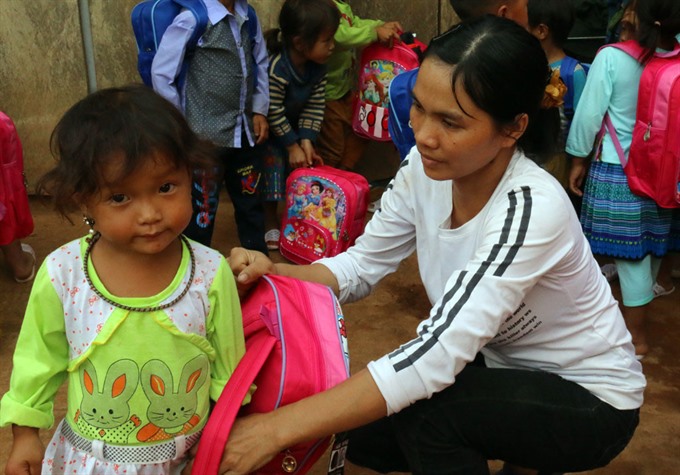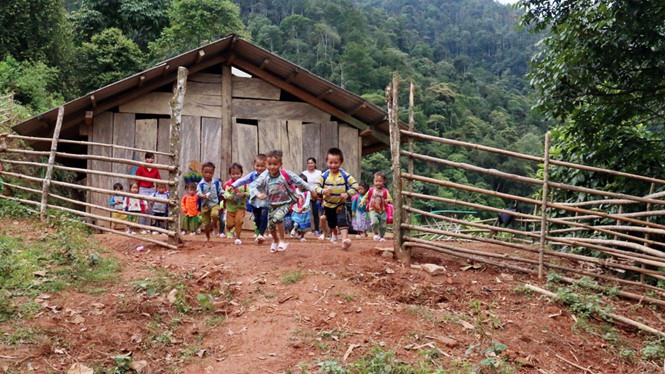 Society
Society

Trạm Tấu District, one of the poorest in the country, has over ten makeshift schools that face great challenges. Of these, the Tà Lù Đằng kindergarten encounters perhaps the most significant obstacles to success.
 |
| Teacher Đoàn Thị Xuyên helps a student put on her backpack. — Photo Mai Thanh Hải |
Mai Thanh Hải
YÊN BÁI — It takes Đoàn Thị Xuyên, 31, three to four hours a day to climb up a trail leading to Tà Lù Đằng kindergarten in a village in the northern mountainous Yên Bái Province to teach the local kids.
The steep and narrow trail leading to Tà Lù Đằng Village in Xà Hồ Commune can be found around five kilometres from the township of Trạm Tấu District. The district, one of the poorest in the country, has over ten makeshift schools that face great challenges. Of these, the Tà Lù Đằng kindergarten encounters perhaps the most significant obstacles to success.
This trail leading to Tà Lù Đằng Village is chiefly used by cows, buffaloes—and teachers, said Mùa A Dế, Chairman of the People’s Committee of Xà Hồ Commune, as he struggled to push his motorbike up the trail.
“Thanks to a road construction project last year, we have enough funds to split mountains and cut down trees to make this road,” he told Thanh Niên (Young People) newspaper. “Earlier, without the road, it was easy to get lost when trying to get to the village.”
Tà Lù Đằng lies around seven kilometres from a provincial road. It has 50 households of 318 Mông ethnic minority people.
People here live on plantations of maize and rice, and raise cows as well. Each kilo of maize is sold at a price of VNĐ29,000 (US$1.3), but only if the farmers can bring the maize down the provincial road, as no traders will make the arduous trek up to the village.
One hundred per cent of people in the village are poor, according to Head of the village Sùng A Khay.
 |
| The students leaving Tà Lù Đằng kindergarten when the school day is over. — Photo Mai Thanh Hải |
The Tà Lù Đằng kindergarten is located in the middle of the village. The wooden house is tottering. Its roof is made of fibro sheets. The roof is deteriorating with many holes, flooding the kindergarten with sunlight or rainwater as the weather dictates.
The house is divided into two rooms. A bigger one, filled with decaying chairs and tables, is used as classroom for around 20 local kids. The smaller one, furnished with wooden boards, is used as a place for the teachers to live.
Xuyên, from northern Sơn La Province, started to work as a kindergarten teacher in Xà Hồ Commune in 2012. She is one of two teachers entrusted to teach at Tà Lù Đằng Kindergarten for the school year that began this August.
After receiving the assignment, Xuyên brought along her 76-year-old mother-in-law and one-year-old son to Tà Lù Đằng Village. She also had to set up their new household at the school with clothes, blankets, sleeping mats and some kitchen utensils.
However, when she reached the kindergarten, she found that it had been left empty for a year without safe water and electricity. Xuyên had to come down the mountain to ask to stay at the house of the village head Mùa A Khay. This means she must climb up to the village to teach at the kindergarten everyday.
“I often wake up at 4am to walk high up to the mountain, around seven kilometres, to reach the kindergarten to welcome the kids,” she said. “I often leave the kindergarten at 4pm, after their mothers pick up all the kids.”
The hard living and teaching conditions however do not discourage the young teacher.
“The kids are small like our children and need to be taken care of,” she said. “We try to wait until their parents collect all of them before leaving the school. In case it is late and dark, we can use light from mobile phone to light the way.”
“I plan to move to the Tà Lù Đằng Village to live at the end of this month as it is nearer to the school. Although it will be much harder, we can stand it,” Xuyên said. — VNS




